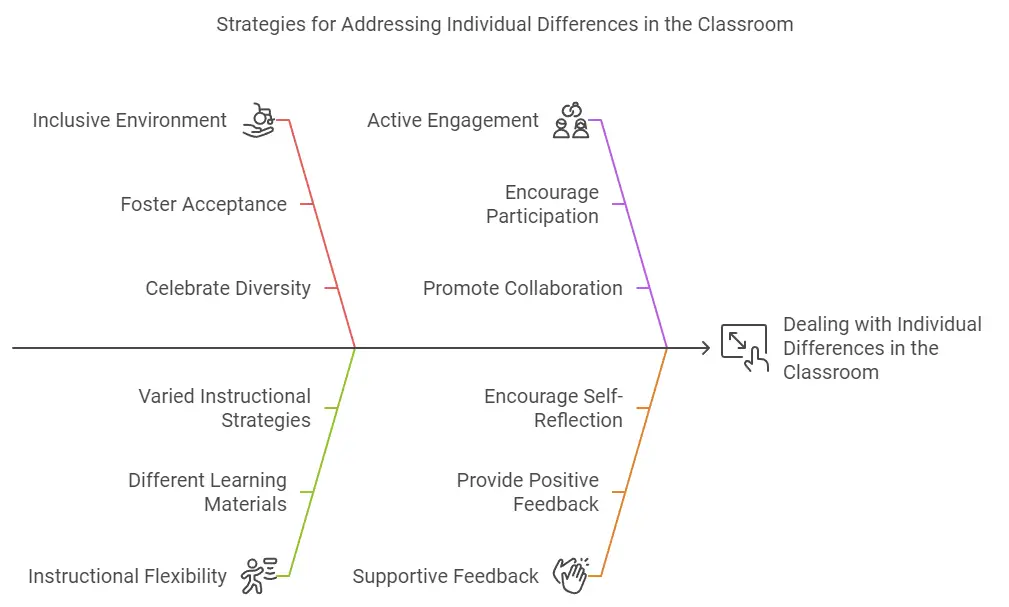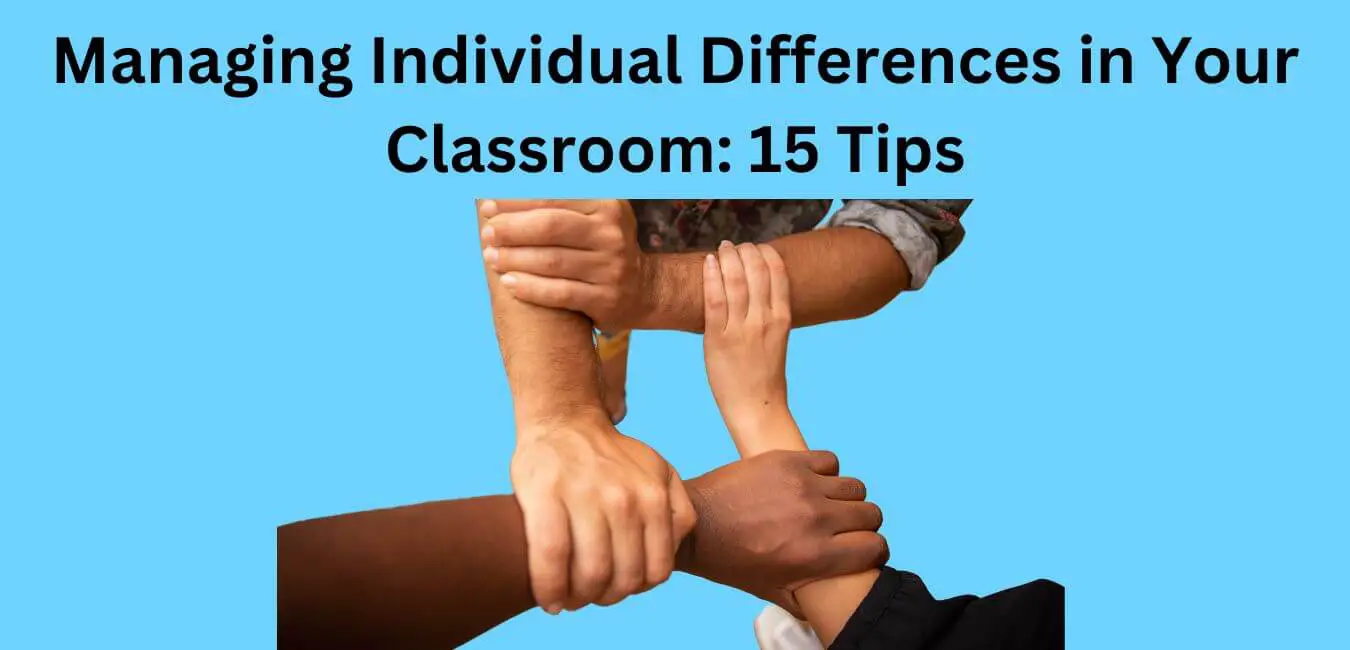As a teacher, you know that every student is unique. But how can you use this knowledge to help create an inclusive and effective learning environment?
In this blog post, I’ve put together 15 strategies that will help you manage individual differences in your classroom. Read on for some helpful tips.
Reasons Why You Should Manage Individual Differences in Your Classroom
Managing individual differences appropriately in the classroom is essential to creating a positive learning environment. This can lead to better student behavior, higher academic performance, and improved social skills. Here are seven reasons why it’s important to manage these differences well:
1. It allows students to be more engaged in their learning and develop a greater understanding of the material.
2. It helps create an atmosphere where all students feel valued and respected.
3. It encourages collaboration and teamwork among students.
4. It promotes creativity by allowing each student to express their own ideas.
5. It can reduce discipline problems caused by miscommunication or misunderstanding of expectations.
6. It strengthens relationships between teachers and students.
7. Managing individual differences appropriately can lead to better student outcomes overall as well as increased satisfaction for both teachers and students alike.

Tips to Handle Individual Differences in Your Classroom
I found the following strategies helpful when dealing with individual differences in my classroom:
1. Recognize and Respect Individual Differences
Recognizing and respecting individual differences in the classroom is essential for creating an inclusive learning environment.
Understanding that each student may have different learning styles, motivations, and interests can help teachers tailor their instruction to meet the needs of each student.
To recognize and respect individual differences, teachers should capitalize on learning styles and multiple intelligences, involve students in setting educational goals, and use computerized instruction when appropriate.
Furthermore, it is important to group students effectively and consider outside placement options for those struggling academically or socially.
With an understanding of individual differences, teachers can create a classroom environment that fosters success for all students.
2. Create an Inclusive Classroom Environment
An inclusive classroom environment is essential for helping students with individual differences.
As a teacher, it’s important to foster an atmosphere of acceptance and respect for all students.
This means creating an environment where everyone feels safe and comfortable sharing their thoughts and ideas.
To create an inclusive classroom environment, try to get to know each student and their individual needs; be mindful of the language you use; and make sure that everyone feels respected and valued.
Additionally, try to create a classroom atmosphere that celebrates diversity, by recognizing and celebrating each student’s unique contributions.
Finally, be sure to provide ample opportunities for different students to work together in groups, as this will help to foster a sense of community and collaboration.
3. Practice Active Listening
Active listening is an important skill when it comes to dealing with individual differences in the classroom.
By actively listening to your students, you can get a better understanding of their individual needs and concerns.
Active listening also helps foster an environment of trust and respect, which is essential for students to feel comfortable enough to open up about their differences.
Active listening involves paying close attention to what your students are saying, repeating back what they have said in your own words to ensure understanding, and asking questions when appropriate.
This will allow you to gain a better understanding of each student’s individual needs and help you create a more inclusive and supportive classroom environment.
4. Be Flexible in Your Instructional Strategies
Flexibility in educational strategies is key when dealing with individual differences.
Different students learn in different ways, so it’s important to be able to adjust your teaching style to accommodate those differences.
To do this, you can capitalize on learning styles, incorporate multiple intelligences into the curriculum, and group students effectively.
Additionally, you can consider outside placement options if necessary.
Make sure to use a variety of instructional strategies, such as computerized instruction and activities that involve student interests, to ensure that all students receive the best learning experience possible.
5. Encourage Participation and Collaboration
Encouraging participation and collaboration in the classroom is a great way to promote learning and respect for individual differences.
By allowing students to take part in discussions, activities, and projects, you are giving them the opportunity to express their ideas and opinions.
This not only promotes a sense of equality and inclusivity but also helps build strong relationships between students.
Furthermore, collaborative activities can help foster creativity, problem-solving skills, and critical thinking skills.
By encouraging participation and collaboration, you are helping to create an atmosphere of acceptance and understanding toward individual differences in your classroom.
6. Provide Differentiated Instructional Strategies
Differentiated instruction is an important way to address individual differences in the classroom.
This approach allows teachers to tailor their instruction to meet the needs of each student.
Differentiated instruction can be used in a variety of ways, such as by providing different learning materials for different students, offering different assignments for different students, and allowing students to work at their own pace.
By providing students with different learning experiences, teachers can ensure that all students can access the material and reach their full potential.
Additionally, teachers should strive to provide a range of activities that are both meaningful and engaging for all students.
By doing so, teachers can foster a sense of belonging and acceptance among all students, while still meeting the needs of individual learners.
7. Encourage Self-Reflection and Self-Regulation
In order to properly deal with individual differences in the classroom, it is necessary to encourage self-reflection and self-regulation.
This involves teaching students to think critically about themselves, their choices, and their learning experiences.
It also requires providing guidance and support to help students learn how to regulate their emotions and behaviors.
Self-reflection and self-regulation skills can help students become aware of their individual differences and give them the tools to cope with them.
By providing opportunities for self-reflection and self-regulation, teachers can help students become better prepared to deal with individual differences in the classroom.
8. Use Technology to Support Different Learning Styles
Technology can be a great tool for supporting different learning styles in the classroom.
It can provide students with a variety of ways to explore and express their individual learning styles.
Technology can be used to create personalized learning experiences, allowing students to access material in the way that works best for them.
This can include using interactive whiteboards, online learning resources, and apps.
Technology can also be used to create virtual classrooms where students can share ideas and collaborate in real time.
Technology can help create an engaging learning environment that allows students to explore and interact with content in a way that is meaningful to them.
9. Set Clear Expectations and Rules
One of the most important strategies for dealing with individual differences in the classroom is to set clear expectations and rules.
This helps to create a sense of order and structure in the classroom, which can help students feel secure and supported.
It is also important to ensure that the expectations and rules are relevant and age-appropriate and that they are consistently enforced.
Establishing clear rules and expectations also encourages students to take responsibility for their own learning and behavior.
Additionally, it is important to remember that individual differences should be respected and that students should not be treated differently based on their differences.
10. Make Use of Group Projects and Activities
Group projects and activities are an effective way to help students learn from each other and recognize their individual differences.
Group projects allow students to collaborate and communicate with each other in a safe and supportive environment.
This can help foster an understanding of different perspectives, as well as a respect for individual differences.
It is important to ensure that all students have an equal opportunity to participate and contribute to the project.
Additionally, providing students with clear instructions and expectations can help ensure that the project goes smoothly.
Setting and managing group expectations, such as deadlines and communication methods, can also help create an environment where individual differences are respected.
11. Provide Visual Cues and Instructions
Providing visual cues and instructions is an effective way to help students in your classroom understand and retain information.
Visual aids can help students better process information, remember key points, and stay engaged.
You can provide visuals with written instructions, diagrams, or pictures.
You can also use videos or audio clips to supplement written instructions.
Visual cues are particularly helpful for students who have difficulty understanding abstract concepts or have difficulty following written instructions.
Visuals can help all students in the classroom, regardless of their individual differences, to better comprehend what they are learning.
12. Manage Stress in the Classroom
Managing stress in the classroom is an important part of helping students cope with individual differences.
It’s important to create a learning environment that is free from fear and intimidation.
Encourage students to be aware of their stress levels and to manage them in a healthy way.
As the teacher, you can set the tone of the classroom and model positive behavior.
You can also provide opportunities for relaxation and self-care activities such as yoga or meditation, and you can incorporate stress-reduction techniques into your lessons.
Additionally, be sure to provide ample time for students to take breaks and have a chance to regroup and refocus.
By creating a stress-free learning environment, you’ll be giving students the tools they need to manage their individual differences.
13. Encourage Social Interaction
Social interaction is an important part of learning in the classroom.
It is essential to create a sense of community and belonging which will help to foster a positive environment for learning.
Encouraging students to interact with each other and participate in group activities can be a great way to help them learn how to work with others and become more understanding and accepting of individual differences.
When students are able to work together and collaborate, they can learn to appreciate and understand different perspectives and opinions.
This will also help them to learn how to solve problems and think creatively.
Additionally, it will help to create a stronger bond between students and foster a sense of community in the classroom, which is essential to successful learning.
14. Provide Positive Feedback
Providing positive feedback is a great way to encourage students to work hard, stay motivated, and build confidence.
Positive feedback should be tailored to individual students to show that you appreciate their efforts and recognize their individual differences.
Positive feedback can come in a variety of forms, such as verbal compliments, praise, and recognition.
Additionally, you can reward students for their successes with small tokens, such as stickers or candy.
By providing positive feedback, you can help create a safe and supportive learning environment where students feel comfortable expressing themselves and their individual differences.
15. Celebrate Diversity in the Classroom
Celebrating diversity in the classroom can help create a safe and supportive learning environment for all students.
It is important to recognize and celebrate the differences in every student, whether it be in race, culture, background, or ability.
We can create a classroom where all students feel respected, accepted, and included by recognizing and celebrating the unique qualities of each student.
This can be done by celebrating special events and holidays, providing opportunities for students to share their experiences, and engaging in activities that explore different cultures and backgrounds.
Celebrating diversity in the classroom can help foster an environment of acceptance, understanding, and respect.

Conclusion
In conclusion, managing individual differences in the classroom can be a challenge for teachers. By understanding each student’s unique needs and implementing strategies such as differentiated instruction, flexible grouping, and student support systems, teachers can effectively manage individual differences in their classrooms.



















